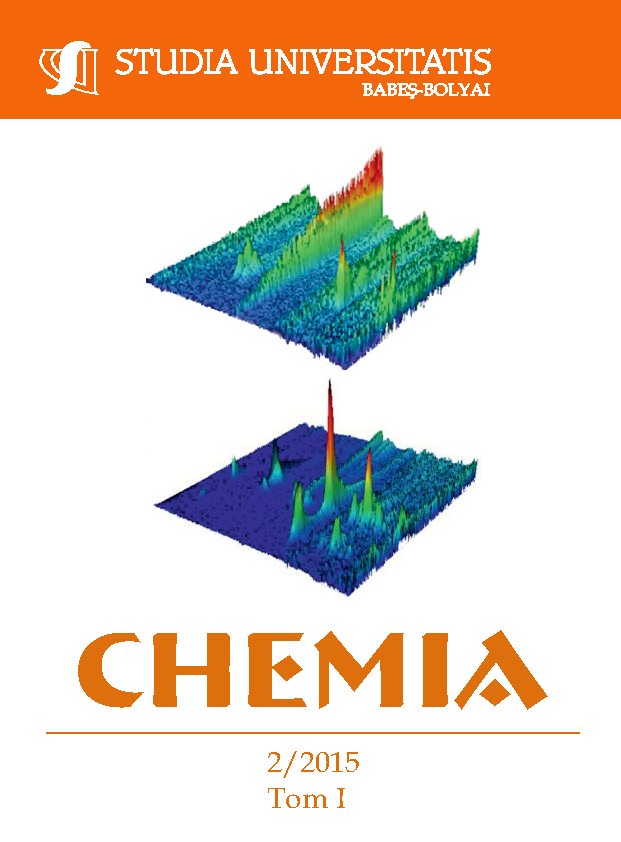ANALYTICAL CAPABILITY AND VALIDATION OF A METHOD FOR TOTAL PETROLEUM HYDROCARBON DETERMINATION IN SOIL USING GC-FID
Keywords:
GC-FID, total petroleum hydrocarbons, validation, measurement uncertainty, soil, fit for purposeAbstract
The paper presents the analytical capability and validation of a method for quantitative determination of total petroleum hydrocarbons in soil by gas chromatography with flame ionization detector (GC-FID). In order to validate the method, the main figures of merit such as limit of detection and limit of quantification, working range, precision and recovery were studied and the measurement uncertainty was estimated based on the bottom-up approach according to the international guidelines of ISO/IEC 17025. Limit of detection, estimated from chromatograms measured for spiked blank at low level mass concentration, was 8.3 mg/kg, while limit of quantification was 25 mg/kg. Precision was studied in terms of repeatability and reproducibility for the concentration range of 25 – 1000 mg/kg. Standard deviation of repeatability (sr) was 6.3% (n=10 parallel samples), while standard deviation of reproducibility (sR) was 9.9 % (n=10 parallel samples). Recovery (%) estimated using a certified reference material (CRM), was 93 ± 7.0 %, while the estimated expanded relative uncertainty was 17.2 %. This paper offers all the steps necessary to validate the determination method for total petroleum hydrocarbons in soil applied according to the standard ISO 16703 and to evaluate the measurement uncertainty for this method. The obtained figures of merit fulfil the requirements of the standardized method and also of the Romanian legislation and demonstrate that the laboratory can properly apply the method in order to achieve accurate results. The paper represents a model for the method validation in analytical laboratories in order to check the fit for purpose of analytical methods.
References
Y. Zhang, M. Liu, H. Chen, G. Hou, Ecotoxicology and Environmental Safety, 2014, 102, 160.
H. Wang, T. Fischer, W. Wieprecht, D. Möller, Environmental Science and Pollution Research, 2015, DOI 10.1007/s11356-014-4049-3.
E. Saari, “Towards minimizing measurement uncertainty in total petroleum hydrocarbon determination by GC-FID”, dissertation thesis, Faculty of Science of the University of Oulu, Acta University Oulu A, 544, 2009.
J.G. Speight, “Handbook of Petroleum Product Analysis”, 2002, John Wiley & Sons, Inc. publication.
J. Bramley-Alves, J. Wasley, C.K. King, S. Powell, S.A. Robinson, Journal of Environmental Management, 2014, 142, 60.
C.M. Reddy, T.I. Eglinton, A. Hounshell, H.K. White, L. Xu, R.B. Gaines, G.S. Frysinger, Environmental Science & Technology, 2002, 36, 4754.
S. Chakraborty, D. Weindorf, B. Li, A.A. Ali Aldabaa, R.K. Ghosh, S. Paul, M.N. Ali, Science of the Total Environment, 2015, 514, 399.
T. Frentiu, M. Ponta, R. Hategan, Chemistry Central Journal, 2013, 7, 43.
M. Senila, E. Levei, L. Senila, O. Cadar, G. Oprea, C. Roman, Studia UBB Chemia, 2011, 56, 27.
A. Drolc, A. Pintar, Accreditation and Quality Assurance, 2012, 17, 323.
M. Ponta, T. Frentiu, Studia Universitatis Babes-Bolyai Chemia, 2012, 57, 7.
R.N. Okparanma, Applied Spectroscopy Reviews, 2013, 48, 458.
L. Senila, A. Gog, M. Senila, C. Roman, L. Silaghi-Dumitrescu, Revista de Chimie, 2012, 63, 557.
ISO 16703, 2004, Soil quality – Determination of content of hydrocarbon in the range C10 to C40 by gas chromatography, International organization for standardization, Geneva, Switzerland.
W. Kessel, Thermochimica Acta, 2002, 382, 1.
A. Drolc, A. Pintar, Accreditation and Quality Assurance, 2011, 16, 21.
JCGM 100:2008, 1995, Guide to the Expression of Uncertainty in Measurement (GUM), International organization for standardization, Geneva, Switzerland.
S.L.R. Ellison, M. Rosslein, A. Williams, EURACHEM/CITAC, “Quantifying uncertainty in analytical measurement”, 3nd edn. LGC, Teddington, 2012.
M. Senila, A. Drolc, A. Pintar, L. Senila, E. Levei, Journal of Analytical Science and Technology, 2014, 5, 37.
ISO/IEC 17025, 2005, General requirements for the competence of testing and calibration laboratories, International organization for standardization, European Committee for Standardization, Brussels.
EURACHEM, 1998, The fitness for purpose of analytical methods, Eurachem LGC, Teddington European Environment Agency, http://www.eea.europa.eu/ data-and-maps/indicators/progress-inmanagement-of-contaminated-sites/progress-in-management-of-contaminated-1.
W. Chang, M. Dyen, L. Spagnuolo, P. Simo, L. Whyte, S. Ghoshal, Chemosphere, 2010, 80, 319.
Ministerial Order 756, 1997, Official Gazette of Romania, 303/bis/06.11.1997.
ISO 8466-1, 1990, Water Quality – Calibration and evaluation of analytical methods and estimation of performance characteristics - Part 1, International organization for standardization, Geneva, Switzerland.
Downloads
Published
How to Cite
Issue
Section
License
Copyright (c) 2015 Studia Universitatis Babeș-Bolyai Chemia

This work is licensed under a Creative Commons Attribution-NonCommercial-NoDerivatives 4.0 International License.



